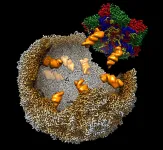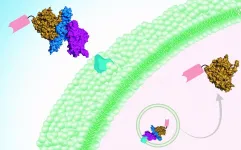Unravelling the mystery that makes viruses infectious
2021-01-08
(Press-News.org) Researchers have for the first time identified the way viruses like the poliovirus and the common cold virus 'package up' their genetic code, allowing them to infect cells.
The findings, published today (Friday, 8 January) in the journal PLOS Pathogens by a team from the Universities of Leeds and York, open up the possibility that drugs or anti-viral agents can be developed that would stop such infections.
Once a cell is infected, a virus needs to spread its genetic material to other cells. This is a complex process involving the creation of what are known as virions - newly-formed infectious copies of the virus. Each virion is a protein shell containing a complete copy of the virus's genetic code. The virions can then infect other cells and cause disease.
What has been a mystery until now is a detailed understanding of the way the virus assembles these daughter virions.
Professor Peter Stockley, former Director of the Astbury Centre for Structural Molecular Biology at Leeds, who part supervised the research with Professor Reidun Twarock from York, said: "This study is extremely important because of the way it shifts our thinking about how we can control some viral diseases. If we can disrupt the mechanism of virion formation, then there is the potential to stop an infection in its tracks."
"Our analysis suggests that the molecular features that control the process of virion formation are genetically conserved, meaning they do not mutate easily - reducing the risk that the virus could change and make any new drugs ineffective."
The research at Leeds and York brings together experts in the molecular structure of viruses, electron microscopy and mathematical biology.
The study focuses on a harmless bovine virus that is non-infectious in people, Enterovirus-E, which is the universally adopted surrogate for the poliovirus. The poliovirus is a dangerous virus that infects people, causing polio and is the target of a virus eradication initiative by the World Health Organization.
The enterovirus group also includes the human rhinovirus, which causes the common cold.
The study published today details the role of what are called RNA packaging signals, short regions of the RNA molecule which together with proteins from the virus's casing ensure accurate and efficient formation of an infectious virion.
Using a combination of molecular and mathematical biology, the researchers were able to identify possible sites on the RNA molecule that could act as packaging signals. Using advanced electron microscopes at the Astbury Biostructure Laboratory at the University of Leeds, scientists were able to directly visualise this process - the first time that has been possible with any virus of this type.
Professor Twarock added: "Understanding in detail how this process works, and the fact that it appears conserved in an entire family of viral pathogens, will enable the pharmaceutical industry to develop anti-viral agents that can block these key interactions and prevent disease."
INFORMATION:
Notes to editors
For further information please contact David Lewis in the press office at the University of Leeds: d.lewis@leeds.ac.uk or on 07710 013287
The paper can be downloaded once the embargo lifts by following this link: https://journals.plos.org/plospathogens/article?id=10.1371/journal.ppat.1009146.%20
Visualisation caption: Capsid protein pentamers (subunits colour-coded) being recruited to the growing protein shell (brown) during virion assembly by formation of sequence-specific contacts between the genome (packaging signals shown as orange space-filled models) and the Enterovirus-E capsid.
The visualisation can be downloaded by following this link.
University of Leeds
The University of Leeds is one of the largest higher education institutions in the UK, with more than 37,000 students from more than 150 different countries, and a member of the Russell Group of research-intensive universities. The University plays a significant role in the Turing, Rosalind Franklin and Royce Institutes.
We are a top ten university for research and impact power in the UK, according to the 2014 Research Excellence Framework, and are in the top 100 of the QS World University Rankings 2019.
The University was awarded a Gold rating by the Government's Teaching Excellence Framework in 2017, recognising its 'consistently outstanding' teaching and learning provision. Twenty-six of our academics have been awarded National Teaching Fellowships - more than any other institution in England, Northern Ireland and Wales - reflecting the excellence of our teaching. http://www.leeds.ac.uk
[Attachments] See images for this press release:

ELSE PRESS RELEASES FROM THIS DATE:
2021-01-08
Corals have evolved over millennia to live, and even thrive, in waters with few nutrients. In healthy reefs, the water is often exceptionally clear, mainly because corals have found ways to make optimal use of the few resources around them. Any change to these conditions can throw a coral's health off balance.
Now, researchers at MIT and the Woods Hole Oceanographic Institution (WHOI), in collaboration with oceanographers and marine biologists in Cuba, have identified microbes living within the slimy biofilms of some coral species that may help protect the coral against certain nutrient imbalances.
The team found these microbes can take up and ...
2021-01-08
More than half of Latina mothers surveyed in Yolo and Sacramento counties reported making economic cutbacks in response to the pandemic shutdown last spring -- saying they bought less food and missed rent payments. Even for mothers who reported receiving the federal stimulus payment during this time, these hardships were not reduced, University of California, Davis, researchers found in a recent study.
"Latino families are fighting the pandemic on multiple fronts, as systemic oppression has increased their likelihood of contracting the virus, having complications from the virus and having significant economic hardship due to the virus," said Leah C. Hibel, associate professor of human development and family studies at UC Davis and ...
2021-01-08
Like Peter Pan, some cells never grow up. In cancer, undifferentiated stem cells may help tumors such as glioblastoma become more aggressive than other forms of the disease. Certain groups of genes are supposed to help cells along the path to maturity, leaving their youthful "stemness" behind. This requires sweeping changes in the microRNAome -- the world of small non-coding material, known as microRNAs, that control where and when genes are turned on and off. Many microRNAs are tumor-suppressive; in cancer, the microRNAome is distorted and disrupted. Recent work by researchers at Brigham and Women's Hospital pinpoints critical changes in an enzyme known as DICER, which create a cascade of effects on this microRNAome. ...
2021-01-08
The BioScience Talks podcast features discussions of topical issues related to the biological sciences.
In a career-spanning installment of the journal BioScience's In Their Own Words oral history series, Missouri Botanical Garden President Emeritus Peter Raven illuminates numerous topics, sharing insights related to the sustainability of human civilization, the COVID-19 pandemic, and the importance of science in addressing the world's greatest challenges.
Raven, a recent coauthor of "A Call to Action: Marshaling Science for Society," highlights the importance of public outreach in overcoming deeply rooted societal problems. Among them, he argues that our present economic system "sees natural productivity like every other ...
2021-01-08
Before the pandemic, the lab of Stanford University biochemist Peter S. Kim focused on developing vaccines for HIV, Ebola and pandemic influenza. But, within days of closing their campus lab space as part of COVID-19 precautions, they turned their attention to a vaccine for SARS-CoV-2, the virus that causes COVID-19. Although the coronavirus was outside the lab's specific area of expertise, they and their collaborators have managed to construct and test a promising vaccine candidate.
"Our goal is to make a single-shot vaccine that does not require a cold-chain for storage or transport. If we're successful at doing it ...
2021-01-08
While rare, botulism can cause paralysis and is potentially fatal. It is caused by nerve-damaging toxins produced by Clostridium botulinum -- the most potent toxins known. These toxins are often found in contaminated food (home canning being a major culprit). Infants can also develop botulism from ingesting C. botulinum spores in honey, soil, or dust; the bacterium then colonizes their intestines and produces the toxin.
Once paralysis develops, there is no way to reverse it, other than waiting for the toxins to wear off. People with serious cases of botulism may need to be maintained on ventilators for weeks or months. But a new treatment approach and delivery vehicle, ...
2021-01-08
More than half of people who use medical marijuana products to ease pain also experience clusters of multiple withdrawal symptoms when they're between uses, a new study finds.
And about 10% of the patients taking part in the study experienced worsening changes to their sleep, mood, mental state, energy and appetite over the next two years as they continued to use cannabis.
Many of them may not recognize that these symptoms come not from their underlying condition, but from their brain and body's reaction to the absence of substances in the cannabis products they're smoking, vaping, eating or applying to their skin, says the University of Michigan Addiction Center psychologist who led the study.
When someone ...
2021-01-08
Gastric bypass surgery is sometimes the last resort for those who struggle with obesity or have serious health-related issues due to their weight. Since this procedure involves making a small stomach pouch and rerouting the digestive tract, it is very invasive and prolongs the recovery period for patients. In a new study, researchers at Texas A&M University have described a medical device that might help with weight loss and requires a simpler operative procedure for implantation.
Researchers said their centimeter-sized device provides the feeling of fullness by stimulating the endings of the vagus nerve with light. Unlike other devices that require a power cord, their device is wireless and can be controlled ...
2021-01-08
TAMPA, Fla. (Jan. 8, 2021)- New research led by the University of South Florida has uncovered one of the reasons jellyfish have come to be known as the "world's most efficient swimmer." Brad Gemmell, associate professor of integrative biology, found jellyfish produce two vortex rings, which are donut-shaped bodies of fluid underneath their translucent bodies, that spin in opposite directions. They appear as jellyfish squeeze and reopen throughout each swim cycle, providing a "ground effect" force as if they were to be pushing off the seafloor.
The "ground effect" is most widely understood ...
2021-01-08
Scientists from Russia, Austria, and the USA have discovered virus-like particles in the bacterial symbionts of Bryozoa - a phylum of colonial aquatic invertebrates - filter-feeders dominating in many bottom ecosystems. The research project was planned and supervised by scientists from St Petersburg University. Some of the virus-like particles resemble red blood cells, while others have a sea-urchin-like appearance. Although viruses have never been reported inside symbiotic bacteria in bryozoans, scientists suggest that this "matryoshka doll" may have a prominent effect on the bacterial ...
LAST 30 PRESS RELEASES:
[Press-News.org] Unravelling the mystery that makes viruses infectious






